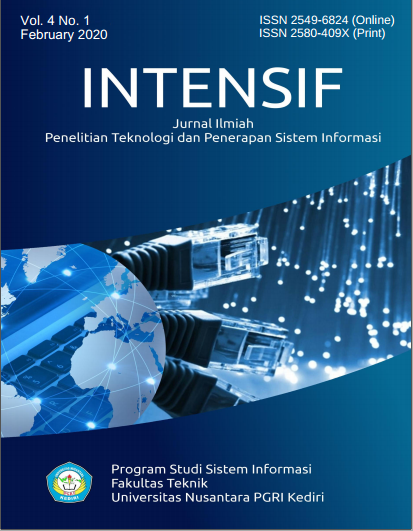Evaluation of Implementation E-Government with Delone and Mclean
DOI:
https://doi.org/10.29407/intensif.v4i1.13067Keywords:
information system, E-government, Delone and Mclean, EvaluationAbstract
This research intends to analyze and test variables that influence implementation E-government, especially in Balikpapan city. The study uses the information system success model DeLone and McLean which has six main variables that can be used to measure the success rate of information systems. Variables that support the success of e-government that support this research include system quality and information quality as exogenous variables. Furthermore, the use and user satisfaction variables are endogenous variables that also affect the net benefits variable. Based on previous research, service quality variables have not been proven to affect endogenous variables, so the researchers omit these variables. Data collection is done by distributing questionnaires to users of e-government services in Balikpapan City as many as 100 respondents. Data processing methods with Structural Equation Modeling (SEM) using the Smart PLS 3.0 approach. This research proves the R-square value of the dependent variable user satisfaction is 62%, and the net benefit variable is 59.1%, which means that the dependent variable can be explained through independent variables in this research model. Based on the findings in the study, it shows that the quality of the system has an effect on user satisfaction but has no impact on use.
Downloads
References
M. A. Sarrayrih and B. Sriram, “Major challenges in developing successful e-government : A review on the Sultanate of Oman,” J. King Saud Univ. - Comput. Inf. Sci., vol. 27, no. 2, pp. 230–235, 2015.
A. K. M. Tarigan, D. A. A. Samsura, S. Sagala, and R. Wimbardana, “Balikpapan : Urban planning and development in anticipation of the post-oil industry era,” JCIT, vol. 60, pp. 246–259, 2017.
S. Lee-geiller and T. David, “Using government websites to enhance democratic E-governance : A conceptual model for evaluation,” Gov. Inf. Q., vol. 36, no. 2, pp. 208–225, 2019.
S. Petter, W. Delone, and E. R. McLean, “Information systems success: The quest for the independent variables,” J. Manag. Inf. Syst., vol. 29, no. 4, pp. 7–61, 2013.
N. P. Rana, Y. K. Dwivedi, M. D. Williams, and V. Weerakkody, “Investigating success of an e-government initiative : Validation of an integrated IS success model,” Inf. Syst. Front., vol. 17, no. 1, pp. 127–142, 2014.
Z. Mahmoodi et al., “The evaluation of a virtual education system based on the DeLone and McLean model: A path analysis,” F1000Research, vol. 6, p. 1631, 2017.
P. H. Saputro, A. D. Budiyanto, and A. J. Santoso, “Model Delone and Mclean Untuk Mengukur Kesuksesan E-government Kota Pekalongan,” Sci. J. Informatics, vol. 2, no. 1, pp. 1–8, 2015.
S. S. Sirsat and M. S. Sirsat, “A Validation of The Delone And Mclean Model On The Educational Information System Of The Maharashtra State ( India ),” Int. J. Educ. Learn. Syst., vol. 1, pp. 9–18, 2016.
M. T. Thielsch, S. M. Meeßen, and G. Hertel, “Trust and distrust in information systems at the workplace,” PeerJ, pp. 1–26, 2018.
M. Karlinsky-Shichor, Yael; Zviran, “Factors Influencing Perceived Benefits and User Satisfaction in Knowledge Management Systems,” Inf. Syst. Manag., vol. 33, no. 1, pp. 55–73, 2016.
H. Mohammadi, “Computers in Human Behavior Investigating users ’ perspectives on e-learning : An integration of TAM and IS success model,” Comput. Human Behav., vol. 45, pp. 359–374, 2015.
G. A. A. Wisudiawan, “Analisis Faktor kesuksesan Sistem informasi menggunakan model delone and McLean,” J. Ilm. Teknol. Inf. Terap., vol. 2, no. 1, pp. 55–59, 2015.
M. N. Yakubu and S. I. Dasuki, “Assessing eLearning systems success in Nigeria : an application of the DeLone and McLean Information Systems Success Model,” J. Inf. Technol. Educ. Res., vol. 17, pp. 183–203, 2018.
B. Tilahun and F. Fritz, “Modeling antecedents of electronic medical record system implementation success in low-resource setting hospitals,” BMC Med. Inform. Decis. Mak., vol. 15, no. 61, pp. 1–9, 2015.
L. Alzahrani, W. Al-karaghouli, and V. Weerakkody, “Investigating the impact of citizens ’ trust toward the successful adoption of e-government : A multigroup analysis of gender , age , and internet experience,” Inf. Syst. Manag., vol. 35, no. 2, pp. 124–146, 2018.
M. Scott, W. DeLone, and W. Golden, “Measuring eGovernment success: a public value approach,” Eur. J. Inf. Syst., vol. 25, no. 3, pp. 187–208, May 2015.
J. F. Hair, G. T. M. Hult, S. M. Ringle, and M. Sarstedt, A primer on partial least squares structural equation modeling (PLS-SEM), 2nd ed. Los Angeles: SAGE Publications, Inc., 2017.
I. Ghozali and H. Latan, Partial Least Squares Konsep, Teknik dan Aplikasi Menggunakan Program Smart PLS 3.0 untuk Penelitian Empiris, 2nd ed. Semarang: Universitas Diponegoro Semarang, 2014.
R. Govindaraju, I. I. Wiratmadja, and A. Haryana, “Pengembangan Model Evaluasi Kualitas Layanan Sistem E-Government,” J. Manaj. Teknol., vol. 15, no. 2, pp. 196–205, 2016.
Downloads
Published
Issue
Section
License
Authors who publish with this journal agree to the following terms:
- Copyright on any article is retained by the author(s).
- The author grants the journal, the right of first publication with the work simultaneously licensed under a Creative Commons Attribution License that allows others to share the work with an acknowledgment of the work’s authorship and initial publication in this journal.
- Authors are able to enter into separate, additional contractual arrangements for the non-exclusive distribution of the journal’s published version of the work (e.g., post it to an institutional repository or publish it in a book), with an acknowledgment of its initial publication in this journal.
- Authors are permitted and encouraged to post their work online (e.g., in institutional repositories or on their website) prior to and during the submission process, as it can lead to productive exchanges, as well as earlier and greater citation of published work.
- The article and any associated published material is distributed under the Creative Commons Attribution-ShareAlike 4.0 International License












